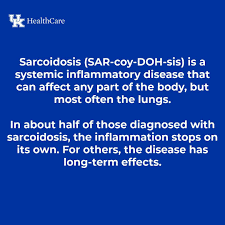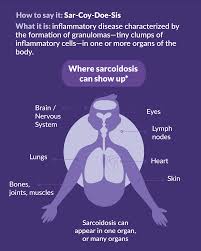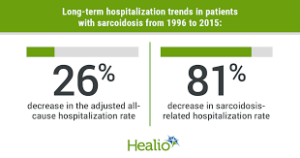How Sarcoidosis can be diagnosed:
- of the lungs, liver, skin, or other affected organs to check for granulomas
- Blood tests, including complete blood counts, to check hormone levels and to test for other conditions that may cause sarcoidosis
- Bronchoscopy, which may include rinsing an area of the lung to get cells or using a needle to take cells from the lymph nodes in the chest
- Chest X-ray to look for granulomas in the lungs and heart and determine the stage of the disease. Often, sarcoidosis is found because a chest X-ray is performed for another reason.
- Neurological tests, such as electromyography, evoked potentials, spinal taps, or nerve conduction tests, to detect problems with the nervous system caused by sarcoidosis
- Eye exam to look for eye damage, which can occur without symptoms in a person with sarcoidosis
- Gallium scan external link , which uses a radioactive material called gallium to look for inflammation, usually in the eyes or lymph nodes.
- High-resolution computed tomography (CT) scan to look for granulomas
- Magnetic resonance imaging (MRI) to help find granulomas. Learn more in our Chest MRI Health Topic.
- Positron electron tomography (PET) scan, a type of imaging that can help find granulomas
- Pulmonary function tests to check whether you have breathing problems
- Ultrasound to look for granulomas
There is a staging to Sarcoidosis:
Doctors use stages to describe the various imaging findings of sarcoidosis of the lung or lymph nodes of the chest. There are four stages of sarcoidosis, and they indicate where the granulomas are located. In each of the first three stages, sarcoidosis can range from mild to severe. This helps the doctor in deciding treatment for the patient. Stage IV is the most severe and indicates permanent scarring in the lungs.
- Stage I: Granulomas are located only in the lymph nodes.
- Stage II: Granulomas are located in the lungs and lymph nodes.
- Stage III: Granulomas are located in the lungs only.
- Stage IV: Pulmonary fibrosis.
Treatment for Sarcoidosis:
Remember there is no cure.
The goal of treatment is remission, a state in which the condition is not causing problems. Not everyone who is diagnosed with sarcoidosis needs treatment. Sometimes the condition goes away on its own. Whether you need treatment—and what type you need—will depend on your signs and symptoms, which organs are affected, and whether those organs are working well; this is also where staging of the disease comes into play. Some people do not respond to treatment.



